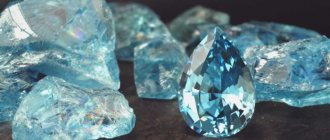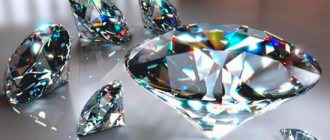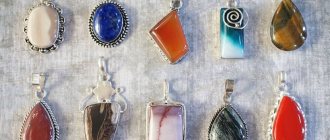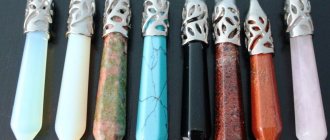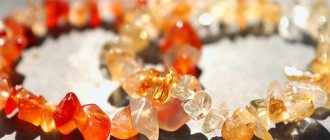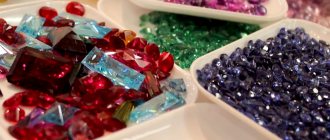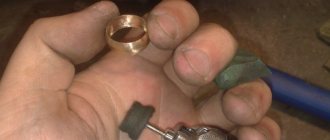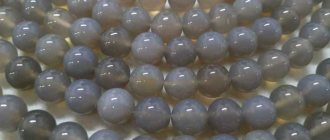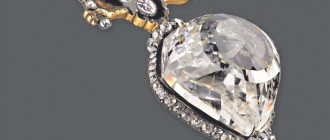The mystical properties of fluorite stone allow it to glow in the dark. The amulets that were created from this mineral were so highly valued in ancient Greek times that their value was equal to gold. This mysterious stone was of great interest to alchemists due to the emission of light and its incredible energy power. It is a mystery to chemists and physicists.
The fluorite mineral is mined all over the world. It is used in industry and jewelry.
Fluorescence effect
Fluorescence is the optical effect of precious stones, which is expressed in their special glow. This happens as a result of exposure to ultraviolet light or heating.
Why do stones glow?
Fluorescence is a visible reflection of chemical processes taking place inside a substance. Under the influence of an external energy source: light or thermal waves, the electrons of atoms transition to a different energy level. Which in turn leads to changes in light parameters.
When was the glow of stones first discovered?
The phenomenon was discovered by the English physicist D. G. Stokes while studying fluorite in 1852. The name is suffixed with “essence,” which is Latin for “weak action.” Subsequently, the term began to be used in relation to gems, to describe their specific characteristics.
What are the types?
According to the degree of intensity, fluorescence can be of several types:
- Zero;
- Weakened;
- Moderate;
- Strong.
from left to right 4 types of fluorescence
Description and types of luminous stones
Glowstones are not a type of natural mineral. They are made specifically for decorating a room or garden plot. Of course, there are minerals that have luminescence, but it is only visible under ultraviolet light. And it is expensive to use such stones as a decorative material.
Fluorescent stones are made in several ways:
- A simple and cheap option is to coat regular pebbles or cobblestones with fluorescent paints. It’s easy to make pebbles yourself, giving free rein to your imagination. They will serve for a long time, you just need to periodically renew the paint.
- Plastic stones with phosphor catalyst. This is already an industrial version. Plastic is mixed with a special chemical composition and cobblestones of different shapes and sizes are made from it. During the day, the composition accumulates sunlight, and in the darkness of the night it releases it. This decoration will work for about 20 years.
- Polymer pebbles with LEDs. Hollow boulders are made from polymer material, and LEDs are placed inside. They look incomparably better than painted stones or cobblestones with a catalyst. However, their service life is short. In addition, LEDs will not work in severe frost.
Painted pebbles or products with a catalyst are suitable for the garden. Polymer pebbles with LEDs are best used for decorating rooms.
Watch the video to see how the stones look on the site day and night:
Price
Anyone can purchase fluorite products.
The cost is influenced by the number and size of stones, frame material (price / rub.):
- bracelet - 500-700;
- beads - 950 - 2450;
- earrings (jewelry alloy) - 360;
- earrings (silver) - 1560;
- ring (silver) - 1,240 - 1,590;
- figurine of a dog (height 10-15 cm) - 14200 - 32700;
- acrobatics (2-4 cm, pcs.) - 240-350;
- agglomerate (24x14.5x15 cm) - 156000.
Fluorite of Chinese origin is mainly used as jewelry and collection material.
Industrial production of fluorescent stones
All three types of glowstones are found in industrial production. And if you can paint pebbles with luminous paint yourself, then it is better to buy LED or catalyst products in specialized stores.
Plastic fluorescent cobblestones are made from plastic mixed with a special chemical composition. This composition is capable of accumulating ultraviolet radiation from sunlight and glowing at night. This decoration does not require special recharging, lasts a long time, and is not afraid of water.
Polymer LED stones are round, hollow containers. They are made of polymer material. A set of LEDs and a battery are placed inside. The decoration requires regular recharging and does not work under water or at low temperatures.
Therapeutic effect
Lithotherapists have identified the healing properties of fluorite:
- Increase stress resistance, neutralize depression, eliminate insomnia and nightmares.
- Treatment of epilepsy, atherosclerosis. Helps to recover after a stroke.
- Strengthens bones, teeth, joints.
- Accelerating the body's regeneration after a serious illness, surgery or injury.
- Regulation of the kidneys and the genitourinary system as a whole.
- Getting rid of conditions caused by weather dependence (migraine, pain).
- Helps the eyes: rest, visual acuity (especially green stones).
The value of fluorite as a beauty stone is enormous. Roller or ball massage rejuvenates the skin.
Wearing fluorite products or raw talisman stones strengthens the immune system.
How to make fluorescent design elements
You can make the simplest and cheapest option yourself - colored minerals. To do this you will need pebbles, a container and fluorescent paint.
Painting each pebble with a brush is time-consuming and labor-intensive, especially if they are small. It is more convenient to use a spray bottle or pouring method. Before painting, the pebbles must be thoroughly washed and dried.
When painting with a spray gun, you need to spread the minerals on a flat surface. Cover one side with dye and wait until completely dry. Turn them to the other side and cover them with paint. The dye should be sprayed evenly so that it does not form streaks.
For pour painting you will need a container. Clean, dried stones are placed in it and filled with dye. The pebbles should only be lightly coated with paint.
Use a clean stick to mix the minerals so that they are evenly colored. If necessary, you can add a little more dye. Then the pebbles are poured out of the container and allowed to dry.
The advantage of glow-in-the-dark stones
Such decor today attracts site owners for many reasons.
- The backlit decor looks amazing at night.
- Helps navigate space at night.
- Glowing stones for landscape design serve as an additional source of light.
- This is very exotic, it is not found in every yard, which allows you to make your site unique.
Making it yourself will not take much effort and time. And the result will please the owner of the site.
Glowing Stone Decor Ideas
The design of a site using luminous stones is limited only by the designer’s imagination.
Glowing paths
An option that allows you to highlight a path on the site. This is the most commonly used type of decoration. The main advantage is practical use. The path is clearly visible in the dark; there is no risk of accidentally stepping into a flowerbed in the dark. With this design, the entire path is isolated, or stones are placed mainly along the curbs.
Milky Way effect
Crumbs or pebbles are scattered randomly along the path or area. At night it looks like a starry sky on earth.
Framing the flower bed
Large cobblestones are used: they look better. They are placed randomly along the edge of the flowerbed. Cobblestones are placed on the flowerbed itself. Paint manufacturers claim that the composition is completely safe for humans and can even be used indoors. But you shouldn’t use such paints to decorate your garden. When it rains or sprays water, paint particles can be washed off the stones and into the soil, which nourishes vegetables and fruits. The chemicals will get into the food. Plastic with chemical catalysts or cobblestones with a built-in mechanism are suitable.
Pond decor
An excellent option for decorating an artificial pond. Plastic stones with chemical catalysts are well suited for this. They will gain light during the day, naturally, and release it at night. The product will not lose its appearance in water and will not deteriorate. But the other two options may suffer from water.
Painting tiles and borders.
It is common to apply luminous compounds to paving slabs and other elements.
- It marks the borders of the edge of the flower bed.
- Apply to the path. It is covered in whole or in part, highlighting some areas.
- Decorate hedges.
- Decorative elements of the fountain.
These and other options will help you navigate and decorate the area with glow-in-the-dark stones.
Where is it used?
The scope of fluorite is quite wide. This is explained by its interesting physicochemical properties and ease of processing.
The stone is most often used in the following areas:
- Production of optical lenses for cameras and video recording devices, as well as microscopes. Pure mineral is more transparent than glass and not as fragile.
- Anthozonite-type fluorites are the raw material for the production of hydrofluoric acid. Hydrofluoric acid is used in aluminum smelting and to add shine to metal products. This substance was discovered during chemical experiments back in 1670 and is still used today.
- It is used in steel and non-ferrous metallurgy. Fluorite is used to make reagents for etching glass, light metals and alloys.
- Although the mineral itself is quite fragile, it is considered a valuable raw material for the synthesis of special polymers called photoplastics. Such connections are very durable and fire resistant.
- Fluorite jewelry can be very diverse. This stone is difficult to work with due to its fragility, but the results are worth the effort.
- Fluorite is a decorative material from which figurines and vessels are cut. They have been in demand among collectors since ancient times. They are brought as souvenirs from travel.
- Fluorite has been used in various rituals and alternative medicine for its magical powers.
Stones with fluorescence effect
Scientists claim that the number of minerals known to science exceeds 3 thousand units. Approximately 500 of them have the property of fluorescence, including:
- Turitella agates, barites, sapphires, and scapolites glow yellow;
- Blue, green, orange, red can be diamonds, rubies and apatites;
- Blue – fluorites;
- Purple – astrophilites, corundums;
- Violet – calcites, microclines;
- Orange – halites, zircons;
- White – porous limestone;
- Light green – chalcedony.
Photo of orange zircon (left), purple microcline (center), three fluorite stones in the first row and pink calcite (right) glowing in ultraviolet light.
Ultraviolet light is not visible to the naked eye. It is generated by the passage of an electrical pulse inside a sealed flask where mercury vapor is under pressure. If you take a filter to block visible light, then with such a lamp you can go in search of minerals.
Fluorescence and jewelry art
The property of phosphorescence is used in jewelry to identify precious stones. Despite the fact that there are currently no unified standards for measuring fluorescence, its presence is an important diagnostic indicator.
Besides fluorite, a common stone that has the same properties is diamond. In most cases, such optical effects can be observed exclusively in ultraviolet light. Some stones can also glow in the sun.
Diamonds, which are transparent at first glance, can shimmer in multi-colored colors in ultraviolet light: they appear blue, yellow, green, pink. The more intense the effect, the more expensive the stone is.
diamond fluorescence
Synthetic stones
One of the ways to increase the cost of artificial gems is to give them various properties, including the ability to exhibit rainbow iridescence and fluorescence.
It is not always easy at first glance to distinguish synthetic stone from natural stone. And identification errors can be costly to buyers. Synthetic stones can be identified by the nature of the light they emit, including the ultraviolet range.
What is a fluorescent mineral?
All minerals have the ability to reflect light. This is what makes them visible to the human eye. Some minerals have an interesting physical property known as "fluorescence."
These substances have the ability to temporarily absorb small amounts of light and instantly release it at a different wavelength. This change in wavelength causes a temporary change in the color of the mineral.
The color changes of fluorescent minerals are most impressive when they are illuminated in the dark with ultraviolet light (invisible to humans).
More about fluorescence
Fluorescence in minerals occurs when a sample is illuminated with a specific wavelength of light. Ultraviolet (UV) light, X-rays, and cathode rays are typical types of light that cause fluorescence.
These types of light have the ability to excite sensitive electrons in the atomic structure of a mineral. The excited electrons temporarily jump to a higher orbit within the mineral's atomic structure.
When these electrons return to their original orbit, a small amount of energy is released in the form of light. This process of releasing light is known as fluorescence.
The wavelength of light released from a fluorescent mineral is often noticeably different from the wavelength of incident light. This leads to a noticeable change in the color of the mineral. The glow continues as long as the mineral is illuminated by light of the appropriate wavelength.
How many minerals glow under UV light?
Most minerals do not have noticeable fluorescence. Only about 15% of minerals have a glow that people can see, and other examples of these minerals will not glow. Fluorescence usually occurs when certain impurities known as "activators" are present in a mineral.
These activators are usually metal cations such as tungsten, molybdenum, lead, boron, titanium, manganese, uranium and chromium. Rare earth elements such as europium, terbium, dysprosium and yttrium are known to contribute to the fluorescence phenomenon. The glow of minerals can also be caused by structural defects in the crystals or organic impurities.
Some impurities quench fluorescence. If iron or copper is present as impurities, they can reduce or eliminate fluorescence. In addition, if the mineral activator is present in large quantities, it may reduce the fluorescence effect.
Most minerals glow in one color. Other minerals have multiple fluorescent colors. Calcite is known to glow in red, blue, white, pink, green and orange.
Some minerals exhibit multiple colors of fluorescence in a single sample. These may be banded minerals that exhibit several stages of growth from initial solutions with varying compositions. Many minerals fluoresce one color under short-wave UV light and a different color under long-wave UV light.
Fluorite: the original "fluorescent mineral"
One of the first people to observe fluorescence in minerals was George Gabriel Stokes in 1852. He noted fluorite's ability to produce a blue glow when illuminated with invisible light "beyond the violet end of the spectrum."
He called this phenomenon "fluorescence." This definition is widely accepted in the fields of mineralogy, gemology, biology, optics, commercial lighting and many other fields.
Most fluorite samples have fairly strong fluorescence. An observer can take them outside, hold them in sunlight, then move them into the shade and see the color of the mineral change. Only a few minerals have this level of fluorescence.
Fluorite typically glows blue-violet under short and long wavelength light. Some samples are known to accumulate cream or white color, but many do not fluoresce. It is assumed that the glow in fluorite is due to the presence of yttrium, europium, samarium or organic material as activators.
Fluorescent geodes?
You may be surprised to learn that geodes (geological formations) have been found with fluorescent minerals inside. Some of the geodes discovered near the community of Dugway, Utah, are filled with chalcedony, which produces a lime-green fluorescence caused by the presence of traces of uranium.
These geodes are amazing for another reason. They formed several million years ago in archaeolite gas pockets. Then, about 20,000 years ago, they were destroyed by wave action along the shoreline of a glacial lake and transported several miles to where they settled in lake sediments. Today, people excavate these geodes and add them to geodetic and fluorescent mineral collections.
Physico-chemical characteristics
From a chemist's point of view, the mineral fluorite is calcium fluoride. The only mineral whose chemical formula contains a fluorine component.
When dissolved in hydrochloric acid, it releases toxic gas.
| Formula | CaF2 |
| Color | White or colorless, violet, blue, blue-green, yellow, brown-yellow or red |
| Line color | White |
| Shine | Glass |
| Hardness | 4 |
| Cleavage | Ideal for {111} |
| Break up | Made a move |
| Density | 3.18 g/cm³ |
| Syngonia | Cube |
| Refractive index | 1,433-1435 |
The red-hot crystals glow in the dark; the mixture with H2SO4 leaves an indelible mark. When heated, they become discolored, but the color is restored when irradiated with X-rays.
Fluorite crystal
Fluorite
Fluorspar is the mineralogical name for fluorite. The stone got its name back in the 16th century due to the fluidity property it possesses. Fluor is translated from Latin as “fluid.” And the “father” of mineralogy, George Agricola, awarded him this name.
But this does not mean at all that the scientist discovered this stone. The mineral fluorite has been used by humanity for many centuries. In ancient Rome, vases made from this mineral were highly valued. But then he was called differently - murin.
And the cost of such things was commensurate with the price of gold items. None of the vases have survived; we can judge their beauty only from descriptions in the works of Pliny the Elder. In Saxony, miners called this stone the ore flower for its unusual color. Objects and jewelry found in the Czech Republic and Ukraine are more than 100 centuries old.
There are many deposits of this mineral. The largest are located in Germany, Scotland, England, China, and the USA. In Russia, it is mined in the Primorsky Territory, Buryatia and Transbaikalia. The most important export suppliers are Mongolia, China and Kazakhstan.
Varieties and physicochemical properties
Fluorite stone can be very diverse. It is impossible to choose a pair of identical stones or even very similar ones - they are all different. Colors range from completely colorless to black. It has a heterogeneous color, with transitions from dark (along the edges) to light (in the center). There may be spots, stripes and stains with a smooth flow of colors.
The most common stones are blue and purple. Yellow, red and green fluorite are often found. And transparent and colorless ones are very rare. The color is directly dependent on the content of rare earth elements, as well as the location of extraction.
Based on the presence of impurities and color, the following groups are distinguished:
- Ratovkit. Color ranges from purple to violet. Fine-earthy, granular and loose structure.
- Yttrofluorite. Enriched with yttrium. Has yellow tints.
- Chlorophane. It contains samarium ions. It is characterized by a green color, which becomes brighter and more saturated as the temperature rises.
- Antozonite. Contains fluoride. Radioactive. Typically dark purple, sometimes almost black. The so-called stinking spar, or Derbyshire amethyst. When crushed or sharply struck, it emits a characteristic fluoride aroma.
- "Blue John" A dense, grainy gem (mined in Devonshire). Two-color striped mineral. Purple with white or yellow.
- Zerfluorite. Enriched with elements of the cerium group.
Crystals most often have a cubic shape, sometimes octahedral, and even more rarely rhombic dodecahedron. They can be single, binary (in the form of two interpenetrating cubes) and aggregate (several crystals and their intergrowths). They have a greasy, glassy sheen.
This mineral belongs to the group of calcium fluorides. Its chemical formula is CaF2. The properties of fluorite stone include the following qualities:
- It dissolves in acids, in particular hydrochloric acid, releasing toxic hydrogen sulfide.
- Melting point above 1360 °C.
- The hardness on the Mohs scale is 4. It scratches very easily.
- When exposed to ultraviolet rays it begins to glow.
- When heated, it changes the density of its internal color and glows in the dark.
- Changes under radioactive radiation.
- Increased fragility. Upon impact, it shatters into pieces.
Application
Fluorite can be called a hard worker stone. Most minerals are mined specifically for production. The use of fluorite in industry is very wide:
- In the production of hydrofluoric acid and anhydrous hydrogen fluoride. For further production of complex fluoride compounds.
- As a flux in the metallurgical industry. Accelerates the melting process, improves slag separation, and lowers the melting point.
- As additives in welding electrodes. They improve the quality and strength of welds.
- In the nuclear industry.
- In ceramic production. In the manufacture of enamels and glazes.
- In the glass industry. To add color to glass and reduce melting time. For making lenses.
- In the production of aluminum. Cryolite, which also contains fluorspar, is used in production.
- In the cement industry. Reduces firing temperature, improves cement quality.
In the jewelry industry, fluorite is practically not used as inserts, although it is considered semi-precious. Beads, bracelets, pendants, etc. are made from it. It is used as an ornamental stone for making figurines, boxes, vases and various souvenirs.
It is of interest to collectors because of its very beautiful, unusual and large crystals. Since ancient times, fluorite has been passed off as real precious stones, such as ruby, amethyst, citrine, and emerald. But it is easily recognized due to its low hardness
Magic properties
They say that it surpasses all stones in its magical qualities, as it glows in the dark. He is considered the most powerful in esoteric terms. It can dramatically change the course of a person’s life, so it must be used wisely. The following magical properties of fluorite can be distinguished:
- opens the “third eye”;
- with its help they look at the future during spiritualistic seances;
- gives the gift of providence;
- gives wisdom;
- improves intuition;
- protects from ill-wishers.
According to the horoscope, fluorspar corresponds most to Aquarius, and to a lesser extent to Pisces and Gemini. Those signs for whom this stone is suitable will receive great energy supply and help from it.
The most valuable is a transparent, colorless mineral. Its energy is beneficial to all zodiac signs. But there is one exception. Fluorite should not be worn by Sagittarius. In them it causes loss of strength, fear and depression.
The crystal is a powerful stimulator of spiritual development, because it distracts from material values and vanity. It is recommended to store it in a tight box or box. It is believed that in the dark the stone accumulates power.
Ancient magicians cherished their talismans like the apple of their eye. A purple pyramid-shaped stone is used for meditation, as it helps to tune into subtle planes. It helps to gain clarity of mind, wisdom and peace of mind.
Medicinal properties
But this stone is used not only in magic. It is also successfully used for medical purposes. It is not used internally (in powder form), since fluoride is harmful to health. It is used in lithotherapy in the form of massage balls for a general restorative massage of the head and body. A number of diseases are treated by applying warm stones. Let's list how fluorite helps:
- relieves headaches;
- normalizes blood pressure;
- improves sleep;
- improves brain activity, relieves epilepsy attacks;
- strengthens the cardiovascular system;
- helps to get out of depression.
Gives energy and strength, relieves stress and fatigue. Calms the nervous system and is highly recommended for people prone to hysterical conditions. Helps with weather dependence.
Transparent fluorspar harmonizes the aura and energizes. Green crystals cleanse energy, heal mental wounds, open the subconscious and enhance intuition. Yellow stones are suitable for creative people; they help unlock potential.
Blue fluorite organizes brain activity and manages energy. The violet or purple mineral is the most mysterious and magical, since it is it that opens the “third eye” and gives common sense.
Fluorite's properties are a powerful talisman and amulet. It is suitable for everyone, not just magicians and soothsayers. It is useful for lovers to have it to protect them from the evil eye; in the family it will protect them from quarrels.
This stone helps lonely people find their soulmate. It will protect you from misfortunes and help you overcome difficulties. It is very useful to carry a fluorite product with you. It could be a ring, earrings or just a keychain.
Amulets, talismans
Alchemists who worked with fluorite for a long time began to consider it the stone of Satan. Everyone who tried to get it died in mortal pain.
Talismans and amulets with such a stone have amazing magical power. It greatly helps develop intuition. Fluorite owners have a “third eye”. It is used during meditation sessions as it helps to find harmony with oneself and with the world around us.
Fluorite is a protective crystal. This is a shield from everything negative. From those trying to get into your head and control your thoughts and even manipulate your consciousness.
This is a stone of creative thoughts and is great for students and scholars. Develops remarkable talents and analytical abilities. Will help you make the right choice in a difficult situation. It absorbs negative energy. Effectively cleanses the environment, as well as the chakras and aura.
It is useful to keep fluorite near your computer; it absorbs negative news and electromagnetic radiation.
The stone has a light aura and has an ancient mystical history. Sorcerers and alchemists attracted clients with such a stone. Spiritualistic sessions with this stone, which glows so amazingly from within, both frightened people and greatly delighted them.
Through a fluorite ball you can look into the future for many years. This rare light generator is the stone of the future. Mineral of the new era, as well as the development of mankind.
How to wear jewelry
The color richness, strong or moderate shine of the stone allows you to choose accessories for ladies of any age and for any occasion.
Men's line: inserts of cufflinks, tie clips, rings. They look non-trivial and solid.
Magicians say that the most powerful “helpers” are a ring, a ring on the ring finger, and earrings. Gold or silver.
The abundance of the stone (especially in beads or bracelets) requires caution: fluorite is able to take the initiative, making a person only a performer.
How to care
Fluorite is fragile, its hardness on the Mohs scale is below average, so you need to carefully care for it:
- The stone may not tolerate frost or heat. The acceptable temperature range is from -4 to +38°C.
- Remove dirt with warm water, a damp cloth and baby soap or a similar mild product.
- Before doing housework, decorations are removed.
- For jewelry, it is better to select a separate box or durable box so that the inserts do not get scratched.
Fluorites, used in magic or healing, cleanse energy dirt. It is enough to rinse them with running water.
Terms of use
How to choose?
You should choose a stone based on your own preferences, its appearance, and your zodiac sign.
According to astrologers, the gem itself chooses its owner, and not vice versa. If the energy of the stone and the person is too different, then fluorite can begin to depress the person and his psychological state. You need to choose a gem based on your feelings. If you feel comfortable and good when you put on jewelry with fluorite, then you should listen to your inner world and buy it for yourself.
How to wear?
It is best to wear earrings or rings with fluorite. This way you can enhance the effect of the stone. You can wear keychains, sew them into clothes, or put them in your pocket.
The stone is able to tune the consciousness of its owner to special waves. If you meditate with this gem, it will finally help you get rid of routine, home fuss, and you will be able to feel alive to the fullest.
How to care?
The stone should be stored very carefully so as not to spoil its appearance or scratch it. It should be placed in a separate box, it will be safest. It should be protected from high and low temperatures. This will have a very negative effect on the condition of the mineral and its appearance. The gem should be cleaned with a soft cloth and a little damp without using soap.
Amulets and talismans can get rid of negativity if you wash them in running water.
Compatibility
If the jewelry is used as a magical or healing artifact, the proximity of fluorite to other gems matters:
- The mineral is fully compatible with amethyst, rock crystal, quartz, lapis lazuli, tourmaline, and citrine. It does not conflict with other “air” minerals.
- “Enmity” depending on the color. White is incompatible with hematite, cat's eye, malachite; green – with diamonds, onyxes.
Antagonist stones weaken each other's magic, nullifying the magical power of the talisman. They are not combined in decorations. It is not recommended to even store it in one box.
Varieties
Based on color, structure and origin, the following types of minerals are distinguished:
- Alpine. Octahedral crystals of the red range, originating from the Swiss Alps.
- Antozonite. Dark purple stone. When separated, it releases fluorine and a specific odor. Radioactive. These properties give rise to other names: fluorite, radiofluorite.
- Derbyshire John. Instances of the blue scale. The structure is usually striped: blue, blue or purple stripes alternate with white, grayish, yellow stripes. Other names: Derbyshire Spar / Blue John / Blue John. Named after the place of production - Derbyshire in the UK.
- Chlorophane. Stones with an intense green fluorescence effect when heated.
- Lithos-lazurite. Stone with red concentric stripes (purple.
- Ratovkit. Typically loose purple stones of sedimentary origin.
Species in which calcium in fluorite is replaced by other elements:
- ichtro-fluorite - with yttrium;
- cer-fluorite - with cerium.
Local names: green stones - "Green John", Transvaal or South African emerald.

